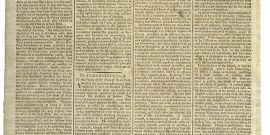The ironic result of the Federalists' efforts is that the increase in national power could actually increase overall liberty for the country.
The State of Our Liberty
The state of our liberty provides the best measure of the state of our union, at least in times of relative peace. It was liberty, after all, that our union was meant to secure. And the news here is not happy. Our economic liberty is on the decline as measured by the annual Heritage report. We have fallen out of the top ten of the nations with greatest freedom to create, trade and keep the fruits of our labor. While Congress had made some cuts in discretionary spending, the entitlement state is on track to take an ever greater share of GDP. And civil liberties have hardly been advanced by the systematic snooping of the NSA.
But beyond these objective indicia, there are deeper signs of trouble for our culture of freedom. The bailout of Wall Street suggested that the government protects the financiers and the one percent. This action in turn has energized the forces of envy that are always just below the surface in a democracy. The election of Bill DiBlasio as Mayor of New York on a theme of two cities shows that the movement is taking virulent political form.
Some might argue that Tea Party shows that the founding spirit of Don’t Tread on Me is alive and well. And there is no doubt that the Tea Party is a better friend to liberty than is Occupy Wall Street. But its agenda has not centrally emphasized cutting middle class entitlements—the transfer spending that is at the root of the relentless rise of federal expenditures and the crowding out of public goods spending that can often be a platform for prosperity. Too often the Tea Party’s focus begins and ends with cutting benefits that the other guy—generally the poorer guy—is getting. A true culture of liberty starts with trimming one’s own dependency on the state.
The President in his State of the Union address last night hardly advanced the cause of liberty. Dictating the wages at which people can work is an intrusion on liberty and a distortion of the market signals that lead to self-improvement. But what was most troubling was the absence of any concrete initiative to contain entitlements or to reform personal taxes by lowering rates and allowing people to make decisions about investments and spending that are not biased by deductions and credits.
Nevertheless it is important not to fall into the delusion that President Obama presents the greatest danger to the culture of liberty. A historian looking back a hundred years from now is likely to group the Reagan, Bush I, and Clinton presidencies together as an era when the state receded or at least did not grow, as measured by regulatory and fiscal burdens on our lives. But Bush II relentlessly increased domestic spending and created more government involvement in health care with the Medicare D program for prescription drugs. It was President Bush who initiated many of the NSA programs.
In short, there are more similarities between Bush II and Obama than their supporters or detractors care to acknowledge. And almost all of the similarities suggest that the risks to our liberty today transcend the actions of any particular politician.
